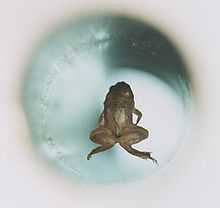Frogs in popular culture
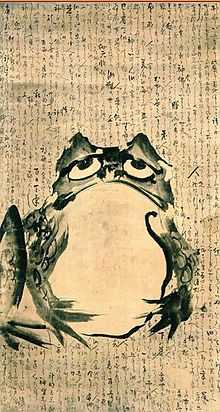
Frogs feature prominently in folklore and fairy tales in many cultures, such as the story of The Frog Prince, up to modern-day popular culture. Pop culture tends to portray frogs and toads as kind, but handsome, and often charming, also with hidden talents. David P. Badger's Frogs (S.l.: Voyageur Press, 2001) includes chapters on "frogs in popular culture, their physical characteristics and behavior, and environmental challenges."[1]
The frogs
The theme of transformation of and into frogs also features prominently, as in The Frog Prince, but also in fantasy settings such as in the Final Fantasy and Chrono Trigger video games that sometimes include magic spells that turn people into frogs.
Frogs are popular subjects of experimentation, as in scientific demonstrations of nerve action and diamagnetism, and cruelty, as in video games such as Frogger and Ribbit King.
Frogs are also used as symbols of disgust due to their moist skin that can be perceived as slimy, and the sometimes repugnant secretions, especially of toads. In the Bible (Exodus 8:6) the Second Plague is one of frogs is sent upon Egypt; this was a deliberate irony by the God of Moses, as the Egyptians saw frogs as a symbol of life and worshiped a frog-goddess. Later, frogs are also associated with unclean spirits in Revelation 16:13.[2]
Frogs are eaten, notably in France. One dish is known as cuisses de grenouille, frogs' legs, and although it is not especially common, it is taken as indicative of French cuisine. Thus frogs are sometimes used to represent French people. Michigan J. Frog, featured in a Warner Brothers cartoon, will only perform his singing and dancing routine for his owner. Once another person looks at him, he will return to a frog-like pose, and begin calling. The Frog Prince is a fairytale of a frog who turns into a handsome prince once kissed. Slippy Toad, a character from the Star Fox series of video games, is a talented mechanic, but mediocre pilot, who often ends up needing to be rescued by his team mates. Kermit the Frog, on the other hand, is a conscientious and disciplined character of Sesame Street and The Muppet Show; while openly friendly and greatly talented, he is often portrayed as cringing at the fanciful behaviour of more flamboyant characters.
Myths, misconceptions and disputes
Frogs fall from the sky in various urban myths. This may derive from real incidents when frogs are picked up by a tornado, or when a sudden migration of frogs happens overnight, which can also happen with fish.
Witchcraft
In medieval Europe the frog was a symbol of the devil due to the Catholic church associating the frog as one of the animals witches use as a familiar.[3]
Boiling frog
The behavior of frogs illustrating nonaction is typically expressed in the story of the boiling frog: put a frog in boiling water and it will jump out, but put it in cold water and slowly heat it, and it will not notice the danger and will be boiled alive. The story has been repeated numerous times to highlight the importance of unnoticed gradual changes.
The story was based on nineteenth century experiments in which frogs were shown to stay in heating water as long as it was heated very slowly.[4] The original 1872 experiment was conducted by A. Heinzmann and this was corroborated in 1875 by Fratscher.[5] The validity of the experiments is disputed. Professor Douglas Melton, Harvard University Biology Department, says: "If you put a frog in boiling water, it won't jump out. It will die. If you put it in cold water, it will jump before it gets hot -- they don't sit still for you."[6]
Warts
It is commonly believed that physical contact with a toad can cause warts on humans. Warts are, in actuality, caused by a human internal viral infection; thus, a toad could not possibly cause a wart. The parotoid glands, which toads use to secrete toxins, are often mistaken for warts. It is widely believed that this myth originated as a measure to ward off children from kissing toads or frogs in an attempt to recreate the fairy tale of the Princess and the Frog.
Ancient beliefs
Egyptian mythology
To the Egyptians, the frog was a symbol of life and fertility, since millions of them were born after the annual inundation of the Nile, which brought fertility to the otherwise barren lands. Consequently, in Egyptian mythology, there began to be a frog-goddess, who represented fertility, named Heget (also Heqet, Heket), meaning frog. Heget was usually depicted as a frog, or a woman with a frog's head, or more rarely as a frog on the end of a phallus to explicitly indicate her association with fertility.[2]
The Ogdoad are the eight deities worshipped in Hermopolis. They were arranged in four male-female pairs, with the males associated with frogs, and the females with snakes
Hapy, was a deification of the annual flood of the Nile River, in Egyptian mythology, which deposited rich silt on the banks, allowing the Egyptians to grow crops. In Lower Egypt, he was adorned with papyrus plants, and attended by frogs, present in the region, and symbols of it.
The Biblical plague of frogs sent to curse ancient Egypt, like the nature of the other plagues, was intended to show the sovereignty of the God of Moses over the gods of Egypt.
Ancient Greece and Rome
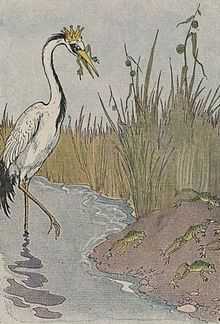
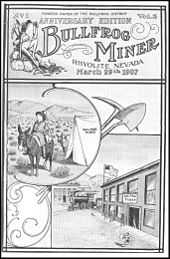
The Greeks and Romans associated frogs with fertility and harmony, and with licentiousness in association with Aphrodite.[2]
- The combat between the Frogs and the Mice (Batrachomyomachia) was a mock epic, commonly attributed to Homer.
- The Frogs Who Desired a King is a fable, attributed to Aesop. The Frogs prayed to Zeus asking for a King. Zeus set up a log to be their monarch. The Frogs protested they wanted a fierce and terrible king, not a mere figurehead. So Zeus sent them a Stork to be their king. The new king hunted and devoured his subjects (as many human kings also do).
- The Frogs is a comic play by Aristophanes. The choir of frogs sings the famous line: "Brekekekex koax koax."
Ancient China
The frog represents the lunar yin, and the Frog spirit Ch'ing-Wa Sheng is associated with healing and good fortune in business, although a frog in a well is symbolic of a person lacking in understanding and vision.[2]
See also: Jin Chan
Indochina
To Vietnamese people, toad is the uncle of the Sky. According to a Vietnamese ancient story, whenever toads grind their teeth, it is going to rain.
South America
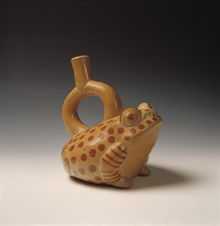
The Moche people of ancient Peru worshipped animals and often depicted toads in their art.[7]
Frog proverbs
- "You can't tell by looking at a frog how high he will jump." - American proverb.
- Vietnamese people have a saying: "Ếch ngồi đáy giếng coi trời bằng vung" ("Sitting at the bottom of wells, frogs think that the sky is as wide as a lid") which ridicules someone who is narrow-knowledged but arrogant. It is similar to the Chinese language sayings "坐井觀天" ("sitting in the well, looking to the sky") and "井底之蛙" ("a frog in a well"). These ancient sayings go back to the Taoist classic Zhuangzi that has a frog living in an abandoned well, who talks about things big and small with the turtle of the Eastern Sea.[8]
- There is even a version in Esperanto: En puto la rano ne scias pri la oceano. ("In the well, the frog does not know about the ocean.")
- "When the snake gets old, the frog gets him by the balls." Iranian proverb.[9]
- "Igual le puedes pedir a un sapo que cante misa." ("You might as well ask a toad to sing the Mass." You are asking for the impossible.) Spanish proverb.
- "Bagai katak dibawah tempurung" ("Like a frog under a coconut shell." To indicate that an ignorant person is like a frog under a coconut shell, not knowing what had happened or is about to happen around it.) Malaysian (Malay) proverb.
Frogs in scientific demonstrations
Frogs have been featured in studies of diamagnetism in biological organisms. As such those organisms were submitted to a large magnetic field (several teslas) produced by a Bitter electromagnet and found levitating due to the diamagnetic features of water (as well as any other substance that is). Apparently a frog was used for the following reason as described by a researcher: "We were amazed to find out that 90% of our colleagues did not believe that we were not joking that water can levitate. It became obvious to us that it was important to make scientists (as well as non-scientists) aware of the phenomenon. We levitated a live frog and other not-very-scientific objects because of their obvious appeal to a broader audience and in the hope that researchers from various disciplines, not only physicists, would never ever forget this often neglected force and the opportunities it offers."[11] Frog levitation plays an important part in the novel Science Fair by Dave Barry and Ridley Pearson. Frog levitation also guaranteed the 2000 IgNobel prize in physics to Michael Berry and to 2010 Nobel Laureate in Physics Andre Geim. [12]
Frogs in confectionery
- Crunchy Frog, a fictitious confectionery from a Monty Python skit of the same name.
- Freddo Frog, a popular Australian chocolate
- Frog cake, a Heritage Listed South Australian Fondant Dessert
- Chocolate Frogs are a popular sweet in the Harry Potter universe. Peppermint toads are also mentioned in one of the books.
- The popular cereal Sugar Smacks has a frog as its mascot.
- Fat Frog was an ice cream popsicle made by Good Humor in the 1980s. The eyes of the Fat Frog character were made out of chewing gum.
Frogs in music
The logo of Australian post-punk band feedtime is a cartoon frog.[13]
Frogs in art
-

Moche frog, 200 AD, Larco Museum Collection, Lima, Peru
-
Ceramic vessel with froghead spout at the Anahuacalli Museum in Mexico City
-
_(5172249722).jpg)
Crapaud et Grenouille by Jean Carriès
-
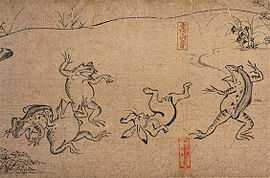
Wrestling frogs from Chōjū-jinbutsu-giga, a piece of cartoon from the 12th century Japan
-
.jpg)
Entre ciel et terre, by Gustave Doré
-
_-_Google_Art_Project.jpg)
Hermenegildo Bustos, Naturaleza muerta
-
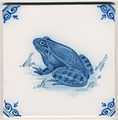
Old Dutch tile from Makkum, Súdwest-Fryslân
-

"My Old Friend Dr. Frog". Promotional postcard for "Frog In Your Throat" Company throat medicine
See also
- Ethnoherpetology
- List of fictional frogs
References
- ↑ ARE THERE FEWER FROGS?
- ↑ 2.0 2.1 2.2 2.3 Cooper, JC (1992). Symbolic and Mythological Animals. London: Aquarian Press. pp. 106–08. ISBN 1-85538-118-4.
- ↑ "The Continuum Encyclopedia of Symbols". Books.google.com. Retrieved 2013-02-17.
- ↑ Sedgwick 1888, p. 390
- ↑ Sedgwick 1888, p. 394. Edward Scripture, The New Psychology (1897): page 300. The original 1882 experiment was cited as: Sedgwick, "On the Variation of Reflex Excitability in the Frog induced by changes of Temperature," Stud. Biol. Lab. Johns Hopkins University (1882): 385. "in one experiment the temperature was raised at a rate of 0.002°C. per second, and the frog was found dead at the end of 2½ hours without having moved."
- ↑ "Next Time, What Say We Boil a Consultant". Retrieved 2006-03-10.
- ↑ Berrin, Katherine & Larco Museum. The Spirit of Ancient Peru:Treasures from the Museo Arqueológico Rafael Larco Herrera. New York: Thames & Hudson, 1997.
- ↑ Zhuangzi, Chapters 秋水 ("The Floods of Autumn") and 至樂 ("Perfect Enjoyment"). Chinese text and James Legge's English translation.
- ↑ Quoted at the end of Embroideries by Marjane Satrapi.
- ↑ Movie
- ↑ (Russian) HFML, Levitation
- ↑ "Winners of the Ig® Nobel Prize". Ig Nobel Prize. Retrieved 19 October 2010.
- ↑ Cohan, Brad (28 March 2012). "The Resurrection of feedtime", Village Voice. Retrieved 30 January 2013.
External links
- The Froggy Page - Frog fun
- History and Lore of the Toad
